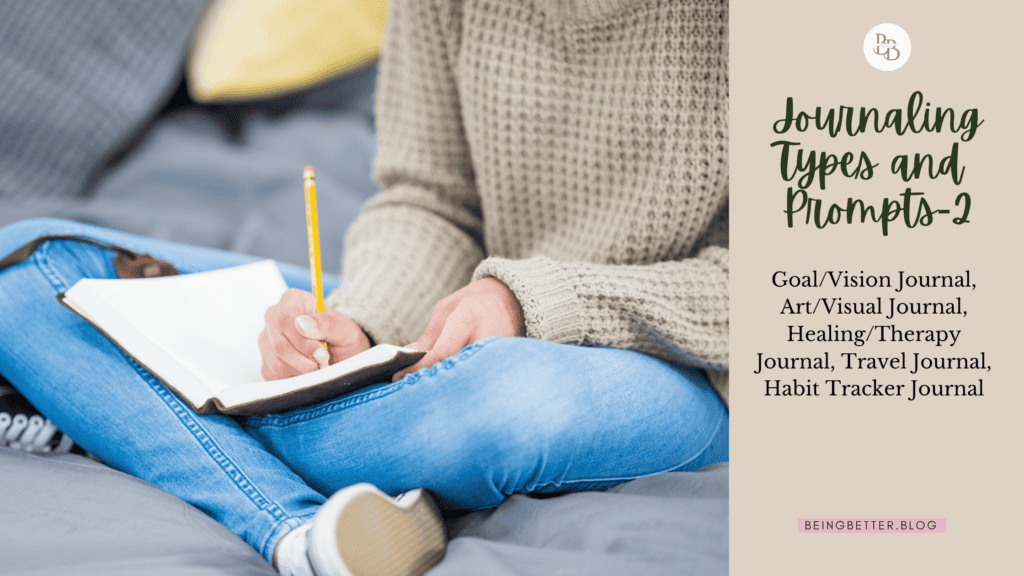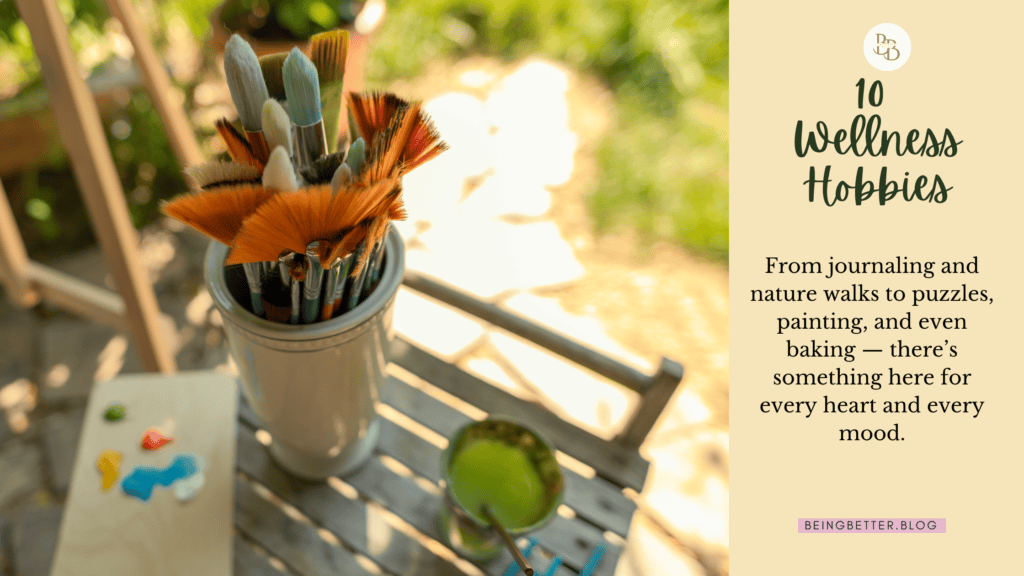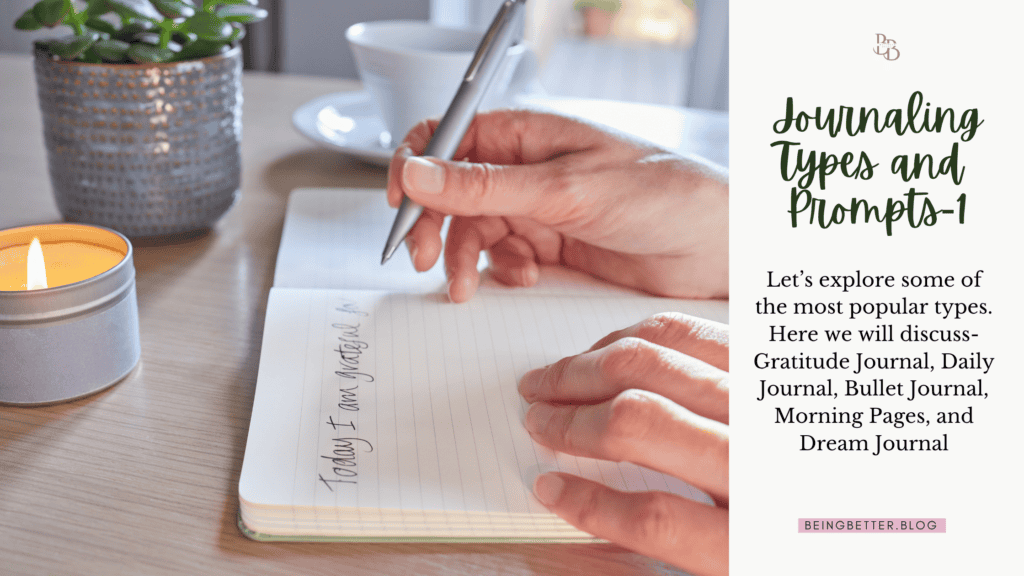Table of Contents
Types of Journaling with Prompts-2
Let’s continue reading on types of journaling and prompts. Here, we will be discussing on -Goal/Vision Journal, Art/Visual Journal, Healing/Therapy Journal, Travel Journal, Habit Tracker Journal
6. Goal & Vision Journal: Turn Dreams into Plans
A goal & vision journal is your personal space to dream big, set clear goals, track your progress, and stay motivated along the way. It helps you create a vision for your life—then break that vision into achievable, meaningful steps.
Think of it as your personal roadmap—a place where your “I wish” turns into “I will.”
Whether your goals are related to health, career, personal growth, finances, relationships, or habits—this journal helps you stay focused, intentional, and empowered.
✍️ How to Start a Goal & Vision Journal: Step-by-Step Guide
Here’s how to build a journal that not only inspires you but also holds you accountable.
1. Begin with a Vision
Start by asking yourself:
- What kind of life do I want to create?
- How do I want to feel in 1 year? 5 years?
- What matters most to me?
Write freely. This is your big picture. Be honest, be bold.
Example: “I want to live a peaceful, purpose-driven life where I feel energized every day, run my own business, and have time for myself and my family.”
2. Break It into Categories
Divide your goals into different life areas:
- 🧠 Personal Development
- 💼 Career & Business
- 🧘♀️ Health & Wellness
- 💰 Finances
- 💕 Relationships
- 🎨 Creativity & Passions
This helps you stay balanced instead of hyper-focused on just one area.
3. Set SMART Goals
Now, turn your vision into specific goals using the SMART method:
- Specific
- Measurable
- Achievable
- Realistic
- Time-bound
Instead of: “Get fit.”
Try: “Walk 5 days a week for 30 minutes and drink 2 liters of water daily for the next 3 months.”
4. Create an Action Plan
For each goal, write down:
- The first 3 steps you can take
- Resources or tools you need
- Challenges you might face and how to overcome them
This is where the magic happens—big goals become bite-sized steps.
5. Track Your Progress
Add weekly or monthly check-ins:
- What did I accomplish?
- What worked well?
- What needs adjusting?
- How do I feel about my progress?
You can use habit trackers, milestone markers, and review pages to stay motivated.
6. Use Visualization
Create a vision board page with:
- Words or quotes that inspire you
- Doodles or drawings
- Magazine clippings or printed images
This taps into your creativity and helps your brain connect emotionally with your goals.
✨ Benefits of a Goal & Vision Journal
This type of journaling is not just about productivity—it’s about purposeful living.
- 🎯 Provides clarity — You know exactly what you want and why.
- 🗂️ Keeps you focused — Regular writing keeps goals top of mind.
- 💪 Boosts motivation — Seeing progress (even small wins) fuels momentum.
- 🧘♀️ Aligns actions with values — You make choices that match your bigger vision.
- 🧠 Reduces overwhelm — Breaking goals into steps makes them less scary.
- 🌟 Inspires growth — Every page helps you become a better version of yourself.
💡 Prompts to Start a Goal & Vision Journal
If your readers are unsure where to begin, they can start with these reflection prompts:
For Vision:
- “If I could design my dream life, what would it look like?”
- “What are 5 things I truly want to experience in the next 3 years?”
- “What kind of person do I want to become?”
For Goal Setting:
- “What is one goal that would change my life right now?”
- “What’s holding me back from going after this goal?”
- “What can I do this week to move one step closer?”
For Motivation & Clarity:
- “Why is this goal important to me?”
- “How will I feel once I achieve it?”
- “What am I willing to let go of to make space for my goals?”
7. Art or Visual Journal: Express What Words Can’t Say
What Is an Art or Visual Journal?
An art journal (also called a visual journal) is a creative space where you combine drawings, doodles, paintings, sketches, collages, colors, textures, and sometimes words to express your inner thoughts, emotions, and daily life.
It’s not about being good at art—it’s about expressing yourself.
Whether you feel overwhelmed, joyful, stressed, hopeful, or confused, your art journal becomes a safe place to release, explore, and heal—without needing to form perfect sentences.
“When I can’t say it with words, I let the colors speak.”
✍️ How to Start an Art or Visual Journal: Step-by-Step
1. Choose Your Journal
Pick a sketchbook or notebook with thick, unlined pages that can handle paint, glue, or ink. A mixed media journal works well.
Tip: Start small. An A5 or A6-size notebook makes it feel less intimidating.
2. Gather Simple Art Supplies
You don’t need a fancy art kit! Start with:
- Colored pens or markers
- Watercolors or acrylic paints
- Old magazines or newspapers for collages
- Glue, washi tape, scissors
- Stickers, stamps, or scrap paper
Let it be fun and low-pressure!
3. Decide on a Theme or Feeling
You can create pages based on:
- A mood you’re feeling
- A quote you love
- A memory or dream
- A topic like self-love, change, or healing
You don’t need a plan every time. Let your emotions guide the page.
4. Start Creating—Freely
No rules. No perfection. Just play with:
- Doodling your feelings
- Smearing colors that match your mood
- Gluing images that speak to you
- Adding textures or patterns
If words come, write them. If not, that’s okay too. The goal is expression, not perfection.
5. Reflect (Optional)
After finishing a page, you can journal beside it:
- “What was I feeling while creating this?”
- “What does this page represent?”
- “What do I want to let go or hold onto?”
Reflection deepens your connection with the page—but it’s not required.
🎨 Benefits of Art or Visual Journaling
This type of journaling is emotionally freeing, even if you’ve never considered yourself an artist.
- 🎭 Expresses emotions you can’t put into words
- 🖌️ Taps into creativity and intuition
- 🧘♀️ Calms your mind and reduces anxiety
- 📖 Makes journaling feel playful and joyful
- 💖 Builds self-awareness and self-acceptance
- 🌈 Boosts mood and emotional release through color and movement
💡 Prompts to Spark Your Art Journal Pages
These are great for readers who don’t know how to begin or feel creatively stuck:
- “Create a page that shows how today felt using only colors.”
- “Collage a dream life. What images or textures represent it?”
- “Draw your safe space. Real or imagined.”
- “Paint or doodle your current emotion without using words.”
- “Pick a quote and create a visual story around it.”
- “Draw how your inner child feels today.”
- “Make a messy page—tear, splatter, and scribble to release stress.”
Remind readers: No page has to be beautiful. It just has to be honest.
8. Healing or Therapy Journal: Write Your Way Toward Inner Peace
What Is a Healing or Therapy Journal?
A healing journal—sometimes called a therapy journal—is a private space to gently explore your emotional wounds, past experiences, and inner struggles, all with the intention of processing, understanding, and healing.
It’s not about reliving pain—it’s about giving yourself a safe outlet to release, reflect, and reconnect with your true self. This type of journal is often used alongside therapy, but anyone can start one to support emotional wellness.
“Some wounds can’t be seen. A healing journal gives them a voice, so they can finally begin to close.”
✍️ How to Start a Healing or Therapy Journal: Step-by-Step
If you’re going through emotional pain, trauma recovery, anxiety, or self-discovery—this step-by-step guide can help you begin safely and gently.
1. Create a Safe and Calm Space
Choose a quiet moment and a space where you feel emotionally secure. Your healing journal should feel like a personal sanctuary.
Light a candle, play soft music, or drink a calming tea before writing.
2. Start Where You Are
You don’t need to begin with your deepest pain. Start with:
- How your day felt emotionally
- A situation that triggered you
- A memory that’s been resurfacing
There’s no “right” place—your heart will guide you.
3. Write Honestly Without Judgment
Let your thoughts and emotions flow freely. Be raw. Be messy. This journal is not for anyone else’s eyes.
- Use “I feel…” or “I’m carrying…” to start
- Write letters to your past self or to someone who hurt you (you don’t have to send them!)
- Express what you wish you could say aloud
You’re allowed to cry. You’re allowed to be angry.
This is your space to feel it all.
4. Don’t Rush to Fix Things
Healing isn’t about quick solutions. Some days you’ll have insights, and some days you’ll just vent. That’s okay. Allow yourself to be where you are.
Some entries might feel repetitive, emotional, or chaotic—and that’s normal during healing.
5. End with a Grounding Practice
After heavy journaling, always come back to the present with something soothing:
- A deep breath
- Writing an affirmation
- Noting something you’re grateful for
- Drawing a calm image or symbol
This helps your mind re-center and feel safe.
🌱 Benefits of a Healing or Therapy Journal
This journal is like a warm companion during tough times. It can offer real emotional shifts:
- 💬 Provides emotional release — You no longer carry everything inside.
- 🔍 Increases self-awareness — You understand where pain comes from and what it needs.
- 🧠 Helps process trauma or emotional wounds — Especially helpful if you’re also in therapy.
- 💖 Encourages self-compassion — You learn to speak kindly to yourself.
- 💡 Leads to powerful insights and breakthroughs — Patterns, beliefs, and inner truths start becoming clear.
💡 Healing Journal Prompts (Especially When It Feels Hard to Start)
When emotions feel too big or unclear, these prompts can gently open the door:
- “Right now, I feel…”
- “What does my pain need me to hear?”
- “What are three things I wish someone had told me when I was struggling?”
- “A memory I’m ready to release or understand better is…”
- “What would I say to my younger self?”
- “What helps me feel safe right now?”
- “What does healing mean to me?”
Use these as starting points. You don’t have to finish them. Let them guide your heart.
9. Travel Journal: Capture Moments, Memories & Magic
A travel journal is your personal storybook of adventures. It’s where you capture your experiences, sights, feelings, and discoveries from your travels—whether you’re exploring a new country, a nearby city, or even your own hometown.
It’s more than just writing what you did—it’s about recording how you felt, what surprised you, what you loved, and how you grew.
“You think you’ll remember everything, but travel memories fade. A journal keeps the magic alive forever.”
✍️ How to Start a Travel Journal: Step-by-Step
Whether you’re traveling for fun, self-discovery, or even a short getaway, here’s a simple guide to help you start journaling your journey:
1. Pick the Right Journal
Choose a lightweight, portable notebook or a digital journal app. Some people love using a blank notebook with space for sketches, tickets, or photos.
Tip: A travel-size notebook (A5 or smaller) is perfect to carry in your backpack.
2. Decide Your Style
You can write in paragraphs, use bullet points, doodle, collage, or mix all of them! It doesn’t have to be formal—make it fun and personal.
Your travel journal is a reflection of your soul in motion.
3. Write Before You Go
Start by journaling:
- Why you’re taking the trip
- What you hope to experience
- Any worries or excitement you feel
- Your travel bucket list or itinerary
This builds excitement and sets intentions.
4. Capture Moments Daily
Each day, jot down:
- Places visited
- People met
- Food tried
- Things you loved or didn’t expect
- Any funny, emotional, or awkward experiences
Even 5-10 minutes at the end of the day can capture so much.
5. Add Mementos
Glue in tickets, receipts, dried flowers, napkins, postcards—anything that brings the memory to life!
Use washi tape, stickers, or simple sketches to make it colorful and personal.
6. Reflect at the End
After the trip, write:
- What you learned about yourself or the world
- Your favorite memory
- Would you go back? Why or why not?
- How did the experience change you?
This reflection turns your journal from a memory log into a personal growth record.
🌟 Benefits of Travel Journaling
A travel journal is more than a souvenir—it’s a soulful snapshot of who you were during the journey.
- ✍️ Preserves memories vividly
- 🌅 Increases mindfulness and awareness during travel
- 💡 Boosts creativity through daily writing or drawing
- 💖 Creates something beautiful and personal to look back on
- 🧳 Helps you process emotions and experiences
- 🧠 Improves storytelling and observation skills
💡 Travel Journal Prompts (Perfect for Writers & Non-Writers!)
Not sure what to write? These simple prompts can help:
- “What surprised me most today?”
- “Describe a moment that made me smile or feel alive.”
- “What did I learn about this place—or myself?”
- “A food I tried today and how it made me feel.”
- “A conversation I had or overheard that stuck with me.”
- “If I could freeze one moment from today, it would be…”
- “Three things I want to remember forever from this trip.”
10. Wellness or Habit Tracker Journal: Build the Life You Want—One Day at a Time
A wellness or habit tracker journal is a practical yet powerful way to stay on top of your self-care, daily habits, physical and mental well-being, and personal growth routines.
It helps you track the small, meaningful actions—like drinking enough water, meditating, sleeping well, or exercising—that lead to long-term health, balance, and happiness.
“What gets tracked, gets done. What gets journaled, gets understood.”
✍️ How to Start a Wellness or Habit Tracker Journal: Step-by-Step
You don’t need to be perfectly organized or ultra-disciplined. This journal is designed to support you, not stress you. Here’s how to begin:
1. Choose Your Format
You can go digital or create your own in a notebook or bullet journal. Many people enjoy drawing habit tracker grids or using simple checklists.
Tip: Start small to stay consistent. A simple layout is easier to stick to.
2. Pick a Few Habits or Wellness Areas to Track
Start by choosing 3–5 things that matter to you. These can be:
- 🥤 Water intake
- 🧘♀️ Meditation or breathwork
- 🚶 Steps walked or exercise
- 😴 Sleep hours
- 📵 Screen-free time
- 🍎 Healthy meals
- 📓 Journaling or reading
- 😊 Mood check-in
- 💊 Taking vitamins or meds
Don’t add too many at once—you’ll build up over time.
3. Create a Daily/Weekly Tracker Layout
Use a grid, circle tracker, checklist, or creative spread. Each day, mark off the habits you completed. Add notes, emojis, or colors to reflect your mood or energy.
4. Reflect Weekly or Monthly
Look at your progress and ask:
- “What worked well?”
- “Where did I struggle and why?”
- “How did my habits affect my mood or energy?”
- “What will I adjust next week?”
This reflection turns a basic tracker into a meaningful self-growth tool.
🌱 Benefits of a Wellness or Habit Tracker Journal
Tracking habits might seem simple, but it creates big shifts in your lifestyle and mindset:
- ✔️ Boosts accountability and consistency
- 🧠 Increases self-awareness around health, mood, and triggers
- 🌈 Encourages progress, not perfection
- 💖 Motivates you with visual growth
- 💪 Builds confidence and self-trust
- 😌 Reduces mental clutter by organizing daily goals
💡 Prompts to Support Wellness & Habit Tracking
These writing prompts pair well with tracking pages to deepen your self-awareness and motivation:
- “Which habit made me feel the best this week and why?”
- “What’s one small action I’m proud of today?”
- “What was the hardest habit to stick with, and what’s stopping me?”
- “How did I care for my body and mind today?”
- “What’s one wellness goal I can simplify or make more joyful?”
Your journal doesn’t just track what you did—it celebrates how far you’ve come.
No matter where you are in life or how you’re feeling right now, there’s a journaling style that can support, inspire, and guide you. Whether you want to heal, grow, stay organized, or simply express yourself—your journal can be your safe space.
Start small, be honest, and let it be messy or beautiful—whatever you need it to be. The more you show up on the page, the more you’ll discover about yourself.
Because in the end, journaling isn’t just about writing—it’s about becoming.



